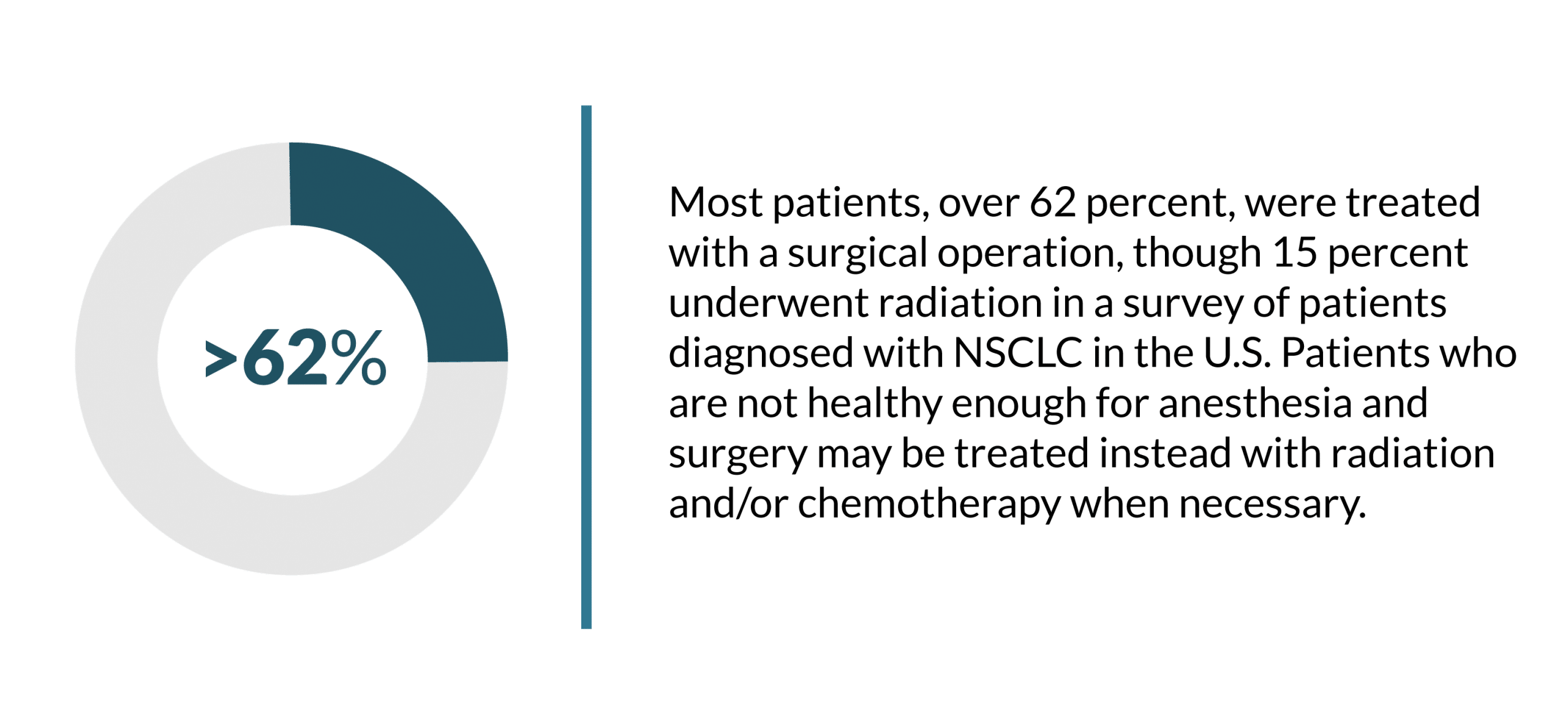Stage I (1) Lung Cancer
Stage I (1) lung cancer is the earliest stage of the malignant disease. Its staging indicates a limited spread of tumors and treatment has the greatest odds of curing the disease, compared to later stages.

What Is Stage I (1) Lung Cancer?
Currently, lung cancer is the most common form of cancer in men and women – more so than breast, colon, and prostate cancers put together – and is the leading cause of cancer death in the U.S. Lung cancer accounts for nearly 25 percent of cancer-related deaths. The outlook for most types of lung cancer is poor due to the aggressive nature of lung tumors. Nonetheless, stage I (1) lung cancers generally have the best prognosis and curative treatment options.
Lung cancer stages are used to describe the location of a person’s cancer and how far it has progressed since development. Generally, stage I lung cancer indicates a limited spread of tumors within a single lung. Of the two primary lung cancer types, small cell lung cancer (SCLC) is more aggressive than non-small cell lung cancer (NSCLC) and grows more quickly.
Typically, the treatments available to patients depend on their cancer’s stage. For instance, some immunotherapy medications are approved only to treat stage IV (4) NSCLC tumors.
Stage I Non-Small Cell Lung Cancer
As the most common form of lung cancer, NSCLC is formally staged from one to four as well as with the TNM staging system issued by the American Joint Committee on Cancer (AJCC) – effective in 2018.

Stage I cancer may be categorized as IA (the primary tumor is three centimeters or smaller) or IB (the primary tumor is between three and four centimeters). Primary tumor growth in the following areas may also disrupt your ability to breathe fully:
- Main bronchus (main airway for the lungs)
- Visceral pleura (tissue membrane around the lung)
- Other areas of the lung causing collapse
Within the TNM staging system, stage IA is equivalent to T1a, N0, M0 (representing zero spread to nodes or other organs) or T1mi, N0, M0 (for minimally invasive adenocarcinomas). Likewise, stage IB is equivalent to T2a, N0, M0.
Further and more detailed AJCC stage groupings for lung cancer are normally used only among doctors, oncologists, radiologists, and other members of a cancer care team.
Stage I Small Cell Lung Cancer
Making up only 10 to 15 percent of lung cancers, SCLC does not have an official staging system. Moreover, SCLC is commonly diagnosed in its advanced stages when the disease has spread beyond the lungs.
Stage I SCLC is typically described as limited-stage cancer. Limited stage SCLC consists of tumors in one lung with partial spread to nearby lymph nodes.
Prognosis and Survival Rates
Not only is the prognosis for stage I lung cancer the best among malignant lung cancers, but it is also improving each year. A prognosis is an outlook for cancer using the current state of the disease as well as the treatment options available. Survival rates generally reflect the outlook for a patient’s cancer but are based on data from previous years. Consequently, your own odds for successful treatment depend on your type of lung cancer, overall health, and how your body responds to treatments like chemotherapy, radiation, surgery, and others.
The five-year survival rates below represent the percentage of patients surviving five years after the date of diagnosis. Usually, NSCLC patients who undergo treatment early after diagnosis of stage I cancer have the best outlook.
| Cancer Type | Stage | 5-Year Survival Rate |
| NSCLC | I (overall) | When diagnosed and treated before spread: 60% |
| IA | 92% | |
| IB | 68% | |
| SCLC | Limited | 29% |
| Mesothelioma | Early | 5 to 10% |
Stage I Treatments
For a majority of stage I lung cancer patients, seeking a second opinion is recommended prior to beginning treatment. Each case of lung cancer is distinct, meaning the composition and progression of tumors in each patient requires different types of treatment. The common treatment methods detailed below are considered the modern approaches to stage I NSCLC and SCLC treatment.
Stage I NSCLC tumors are sometimes removable via surgery in a process called lobectomy, segmentectomy, or wedge resection (i.e., resection of a portion of a lobe of the lung). Most patients – over 62 percent – were treated with a surgical operation, though 15 percent underwent radiation in a survey of patients diagnosed with NSCLC in the U.S.
Patients who are not healthy enough for anesthesia and surgery may be treated instead with radiation and/or chemotherapy when necessary. These methods may also be used to shrink tumors before or after surgery.

Other, newer cancer treatment techniques being explored for their efficacy in eliminating tumors in those who cannot go through surgery include:
- Adjuvant Lung Cancer Enrichment Marker Identification and Sequencing Trials (ALCHEMIST)
- Opdivo® (nivolumab) and Keytruda® (pembrolizumab)
- Proton therapy
- Stereotactic body radiotherapy (SBRT)
- Video-assisted thoracic surgery (VATS)
The common treatment approach for SCLC is chemotherapy followed by radiation therapy to shrink and kill tumors. Spread to lymph nodes often removes surgery as an option of treatment.
If you’re unable to endure certain treatments, or if modern technologies are not available at your closest hospital, clinical trials may offer the best potential for curative treatment. For example, a European trial is in the process of testing a combination of Opdivo and immunotherapy medication Yervoy® (ipilimumab) on limited-stage SCLC.
Potentially, lung cancers can be cured in stage I. The rate of recurrence is between 30 and 55 percent; adjuvant chemotherapy may be administered to reduce the risk of recurrence. When stage I lung cancers return after a period of remission, they often do so at distant locations around the body (i.e., stage IV).
For more information about the effects of lung cancer as well as compensation for medical bills, fill out a free case evaluation form.


